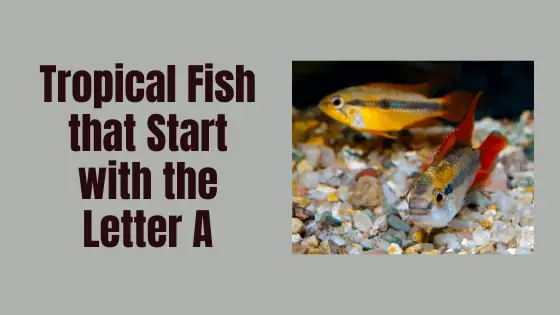Did you know there are well over 30,000 different species of tropical fish identified? This number continues to rise as more species are discovered.
This article will give you a list of our 7 favourite tropical fish beginning with the letter A.
Some you may have heard of, whilst some I am sure you won’t as they are more unusual. We are using their common names, as who actually uses their scientific names when popping into the local pet shop?! I have included the scientific names as well though for the nerdy types.
For the purpose of variation (and because, quite frankly, some of these letters were hard to research!), we may have included some saltwater fish as well. These are clearly marked, as rule number 1 in the world of fishkeeping is that you can’t mix your freshwater fish with your saltwater fish.
Tropical Fish that Start with the Letter A.
- African Glass Catfish
- Arched Corydoras
- Agassiz’s Dwarf Cichlid
- Ahli Cichlid
- American Flagfish
- Archer Fish
- African Lungfish
African Glass Catfish.
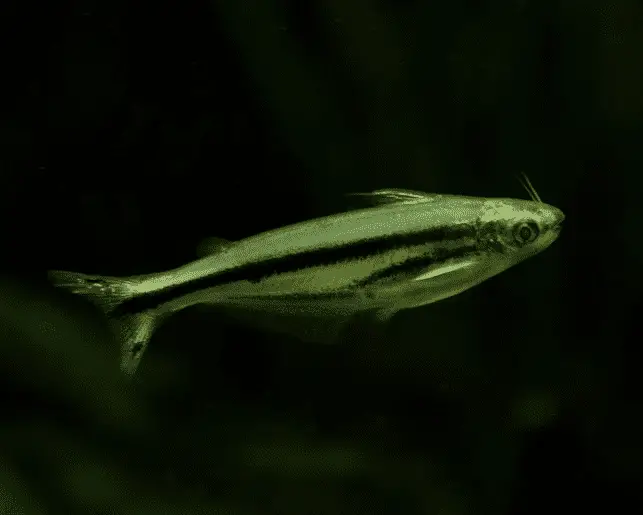
Scientific name: Pareutropius debauwi.
The African Glass Catfish is a social and peaceful shoaling fish that originates from Western Africa. They can grow to approx 3 inches.
They get their name due to having a partially transparent body, which can resemble glass when caught in the light. They also have a black stripe that carries all the way down their body.
Arched Corydoras.
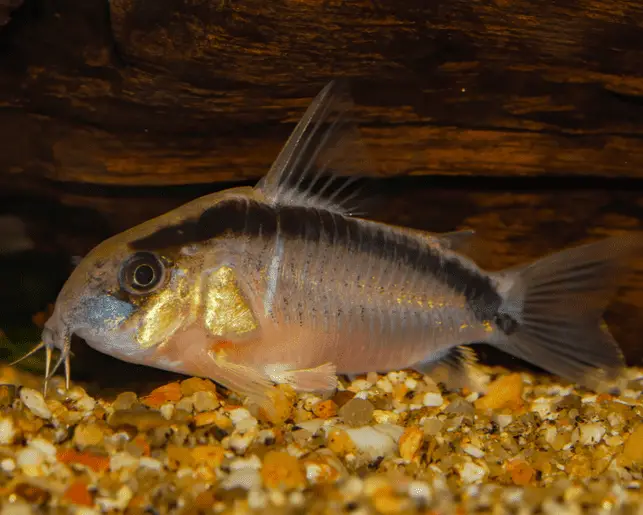
Scientific name: Corydoras arcuatus.
The Arched Corydoras is an extremely peaceful fish that is a great addition to a community tank. They grow to approximately 3 inches and hail from South America, most notably Ecuador, Peru and Brazil.
They like nothing better than minding their own business, mooching around the bottom of the tank.
They have a pale pink body with a very distinctive black arched stripe that goes from the mouth, along the top of the upper body right to the base of the tail. On the male the stripe is a lot more distinctive than on the female.
They are also known as the Skunk Corydoras, which again, refers to their black stripe.
Agassiz’s Dwarf Cichlid.
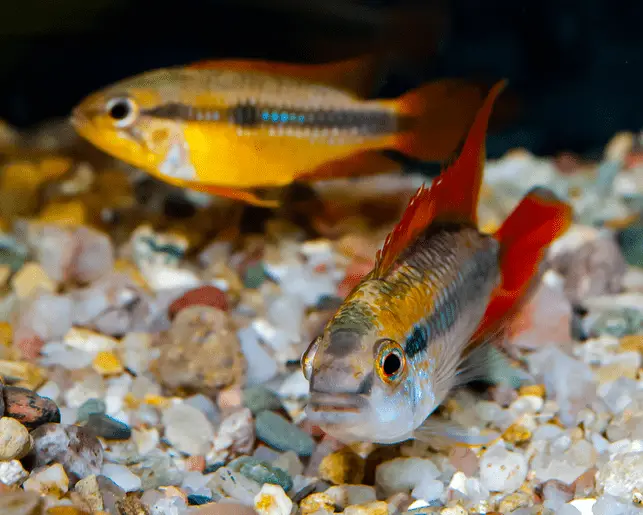
Scientific name: Apistogramma agassizii.
There are a few colour variations of this species, but they all have a strong yellow colour on their body. As is very common with tropical fish, the males have a much stronger colouring than the females.
Agassiz’s Dwarf Cichlids originate from South America, in the Amazon region. They grow to around 4 inches and are mostly peaceful. The males can get a bit tetchy and territorial, but if you have a big enough tank, with lots of space, that shouldn’t be an issue.
Ahli Cichlid.

Scientific name: Sciaenochromis fryeri.
The brown eyed Ahli Cichlid can be a bit of a nark, especially with other males and also fish that are a similar colour to them. They are also very good at destroying plants!
The males have the most amazing blue colour which has darker stripes along the body. These stripes can look more prominent when they’re about to kick off. As usual, the females don’t have as vivid a colour. In fact, they tend to look more grey than blue.
The Ahli Cichlid originates from Lake Malawi in Eastern Africa, and they can grow to an impressive 7 inches.
If you are wanting to mix them with other species, they would need to be with less aggressive Cichlids that are a completely different colour. There should only ever be one male Ahli in the tank as well to help make sure there is no fighting.
American Flagfish.
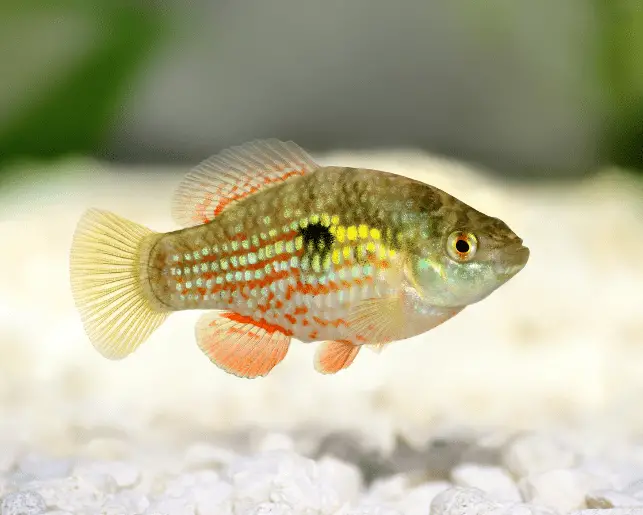
Scientific name: Jordanella floridae.
Apparently, the American Flagfish gets their name because during their breeding season, the colours on the males resemble the stars and stripes of the American flag! Females are easy to spot as they tend to have black markings around their dorsal fin and are a lot duller.
They are a member of the killifish family and originate from around the Gulf Coast. They have a very narrow and quite deep body, and can grow to about 2 inches.
Their natural habitat is densely vegetated, so they are happier in a very well planted tank. Being too exposed makes them very nervous.
The females are peaceful. The males can get a bit aggressive, but a well planted tank and lots of swimming space will put a stop to that.
Archer Fish.

Scientific name: Toxotes jaculatrix.
The Archer fish has a unique way of hunting insects in their natural habitat-by shooting them!
Now, they aren’t packing a piece under their fins or anything. They have the ability to shoot a powerful jet of water out of their mouths, which can knock an unsuspecting insect off their perch. They loiter just underneath the surface of the water looking for a victim. When they spot one, they try and get as directly underneath it as possible, before sucking water into their mouth and then firing off the jet of water that can be effective for up to 5 feet. This then knocks their victim into the water. The accuracy of their shooting is something that gets better as they mature. Baby Archer fish are a bit rubbish with their aim.
Archer fish can grow up to 10 inches. They are native to Asia, and have distinctive black markings, as well as a yellow tinge to their caudal fin.
African Lungfish.
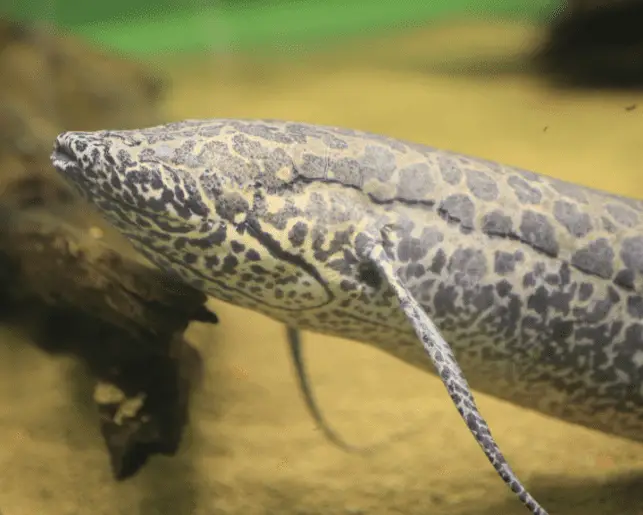
Scientific name: Protopterus annectens.
You won’t be fitting an African Lungfish into a traditional sized tank. These literal bad boys can grow up to 26 inches!
They need to be kept on their own as they are aggressive and predatory. They originate from Africa and are very distinctive looking, with their grey body and almost prehistoric looking markings.
Lungfish get their name because they are able to breathe air out of water. They are used to shallow waters, and when those shallow waters dry up, they bury themselves into the substrate and cocoon themselves in. They can stay like this for months.

